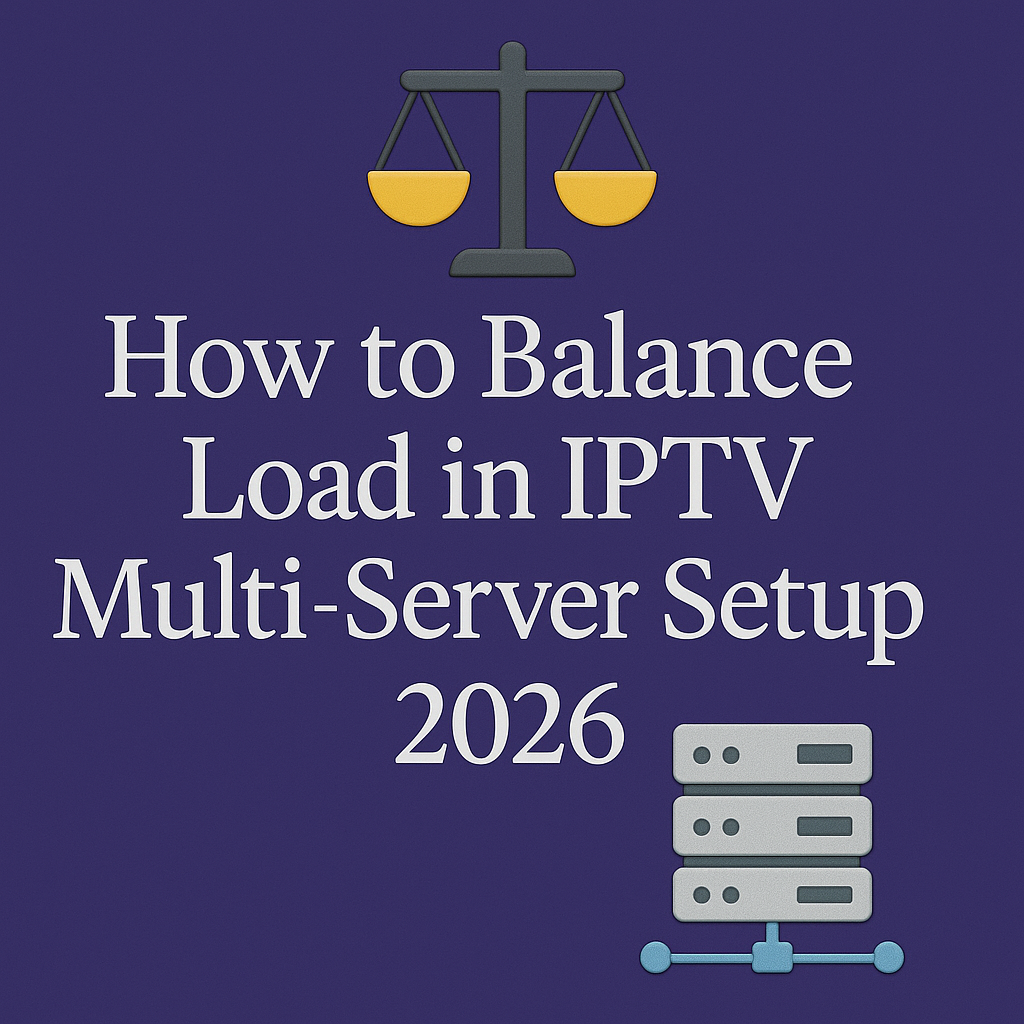How to Balance Load in IPTV Multi-Server Setup 2026

⚖️ Ever noticed how some IPTV streams crash during big football matches or peak hours? That’s usually because one server gets overloaded while others sit idle. In 2026, load balancing in IPTV multi-server setups is the secret sauce that keeps streams smooth and reliable. Let’s unpack how it works and why it matters.
🔍 Why Load Balancing Matters in IPTV
Load balancing distributes traffic across multiple servers so no single machine becomes the bottleneck. For IPTV, this is critical because:
- 📈 High Demand: Popular live events attract thousands of viewers at once.
- ⏱️ Latency Sensitivity: Even a few seconds of delay can ruin the viewing experience.
- 📉 Server Failures: If one server goes down, others can take over seamlessly.
- 🌍 Global Audience: Users across regions need to connect to the nearest server for speed.
Think of load balancing like traffic lights at a busy intersection — without them, chaos is guaranteed.
🧩 Step 1: Understand Load Balancing Basics
In IPTV, load balancing isn’t just about splitting traffic — it’s about smart distribution. The main techniques in 2026 include:
- 🔄 Round Robin: Sends each new connection to the next server in sequence.
- ⚡ Least Connections: Directs users to the server with the fewest active streams.
- 📊 Weighted Balancing: Gives more powerful servers a bigger share of the traffic.
- 🌐 Geo Load Balancing: Routes viewers to the closest regional server for faster delivery.
💡 Pro Tip: Most IPTV providers use a mix of these methods to keep performance consistent.
🛠️ Step 2: How to Implement Load Balancing
Now that you know the basics, let’s talk about how IPTV providers and tech-savvy users actually implement load balancing in 2026:
- 🌐 DNS Load Balancing: Uses DNS servers to direct users to the best-performing IPTV server. Simple but less precise.
- ⚙️ Reverse Proxies: Tools like Nginx or HAProxy sit between viewers and IPTV servers, intelligently routing traffic.
- ☁️ Cloud Load Balancers: Services from AWS, Google Cloud, or Azure distribute IPTV traffic across global data centers.
- 📡 Edge Servers: Content delivery nodes closer to the end-user reduce latency and balance demand regionally.
Each method has pros and cons. Smaller IPTV setups may use DNS, while large-scale providers often combine proxies and cloud services.
📊 Step 3: Monitor and Optimize
Load balancing isn’t a “set it and forget it” deal. You need to constantly monitor performance and adjust:
- 📈 Grafana & Prometheus: Visualize server load, response time, and active streams.
- 🕵️ Zabbix: Alerts you when a server hits critical load or goes offline.
- 🤖 AI Optimizers: Modern tools can auto-adjust balancing strategies based on usage trends.
- 🔍 QoS Metrics: Track latency, jitter, and packet loss to refine distribution.
💡 Quick Tip: Schedule stress tests during peak hours to see how your system handles heavy loads.
🔍 Reality Check
Load balancing sounds perfect on paper, but here’s the truth:
- ⚠️ Costs Add Up: Cloud load balancers and global edge networks can get pricey.
- ⚠️ Complex Setup: Requires technical knowledge to configure proxies and routing rules.
- ⚠️ Overhead: Extra layers (like proxies) can add milliseconds of latency.
- ⚠️ No Magic Fix: If your IPTV provider’s servers are weak, load balancing won’t save you.
👉 Bottom line: load balancing improves performance, but it works best when paired with strong infrastructure and reliable IPTV service.
❓ Frequently Asked Questions (FAQ)
1. Do I need multiple servers for IPTV load balancing?
Yes, load balancing only works if you have more than one server handling traffic.
2. Is DNS load balancing enough for IPTV?
It works for small setups but lacks precision compared to proxy or cloud methods.
3. Can I use free tools for load balancing?
Yes, Nginx and HAProxy are free and widely used, though they require setup skills.
4. Does load balancing improve IPTV quality?
Indirectly, yes — by distributing users, it prevents server overload and buffering.
5. How do I monitor IPTV server load?
Use dashboards like Grafana or Zabbix to track CPU, bandwidth, and active sessions.
6. Is cloud load balancing worth it?
For large-scale IPTV providers, yes. For home users, it may be overkill.
7. Can load balancing fix poor internet?
No, it only manages server load. Your own connection quality still matters.
8. Does balancing add latency?
A tiny bit, but it’s outweighed by the stability benefits.
9. What’s the easiest method for beginners?
DNS load balancing is simplest, though less powerful than proxies.
10. Do premium IPTV providers use load balancing?
Yes, the best ones use multi-layer balancing to ensure smooth service globally.
✅ Final Verdict
Load balancing in IPTV multi-server setups is the backbone of smooth streaming in 2026. By spreading traffic intelligently, it prevents overloads, reduces buffering, and keeps your streams running even during peak demand.
Of course, the effectiveness of load balancing depends heavily on your IPTV provider. That’s why choosing a reliable service matters. We recommend Premium IPTV by CCCAM2. With robust infrastructure and optimized servers, it’s built to handle heavy loads gracefully.
👉 Pair a strong provider like this one with proper load balancing, and you’ll enjoy stable, high-quality IPTV streams anytime, anywhere.






